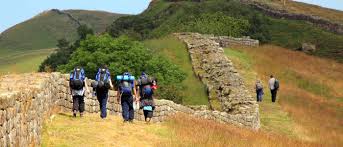The roman conquest of Britain played a profound role in shaping the nation we know today. Since Emperor Claudius sent the first four legions across the English Channel in AD 43, the influence of Roman culture, technology and thinking would be found in almost everything that was to follow. If you’re a Briton with an interest in Roman history, you needn’t travel far to feed that interest – because the country is covered in Roman sites that’ll excite your curiosity. Let’s take a look at some of the best of them.
Hadrian’s wall
Hadrian’s wall Is the site that will come to mind immediately; it’s the most enduring relic of the period, and one which still stretches eighty miles across the north of England. During construction, the Romans built several forts and settlements across the length of the wall. The largest and most noteworthy of these today is probably Housestead’s fort, which is open throughout the year and provides visitors with a chance to examine the barracks, hospital and toilets used by roman soldiers almost two thousand years ago. Another settlement along the wall which is noteworthy is Vindolanda, an attraction which consists not just of the settlement itself, but a fully-equipped museum which offers visitors a chance to enjoy live archaeology demonstrations during summer.
Antonine Wall
Slightly less-well-known is the Antonine Wall, which was constructed further north, across the centre of what is now Scotland. The wall splits the firths of Forth and Clyde, and was constructed over the course of around twelve years from AD 142, at the behest of Emperor Antonius Pius. The wall was constructed in order to repel the pesky Caledonians, and was protected by sixteen different forts.
If you’d like the best learning experience concerning the wall and its construction, the Hunterian Museum in Glasgow is probably the best place to go. A visit to Rough Castle, the best-preserved of all the sixteen forts, should also be considered fairly obligatory.
If you’re just after a bracing hike through the history of the region, then a walk along the site of the wall will prove eminently suitable. Since the Antonine Wall was built from wood rather than stone, there’s not much evidence of its construction left – but you’ll still be able to see the mark the project left on the Scottish landscape.
Chester
Chester was a settlement of enormous strategic importance to the Roman settler in the UK. It was used as a military staging ground for incursions further north, and was intended to be used to prepare a fleet for an invasion of Ireland which ultimately never came to pass.
You’ll find all things Roman in strong evidence in Chester – most obviously in the form of the walls, which run through the middle of the city, and the amphitheatre, which was once used to entertain roman soldiers. If you’re looking for somewhere to stay during your visit to this part of the world, then you’ll be pleased to learn that there are a wealth of quality hotels in Cheshire. Of these, you might consider Carden Park, whose grounds are home to some of the most reputable hotels, entertainment complexes and conference venues in Cheshire.
Bath
Bath is home to some of the most noteworthy and well-preserved Roman buildings in the country, most famously the baths from which the town draws its name. Visitors will be able to enjoy the Great Bath, as well as the Temple to Minerva. Roman baths involved some engineering which was incredibly advanced for the time, and included innovations like underfloor heating systems and hot and cold water.
Caerleon
If you’re in Wales, then a visit to Caerleon should be considered mandatory. It’s home to a well-preserved Roman fortress and baths. Included here are heated changing rooms, and a series of hot-and-cold baths. While the baths themselves aren’t quite as extensive as those you might find in Bath, the place is still worth a visit – as they provide a vivid illustration of life in Britain during the first and second centuries. Visit nearby Caerwent, and you’ll be able to see the remains of a temple and forum, too.
Portchester Castle
If you’re on the south coast, then you’ll have access to some of the best-preserved Roman ruins that the island has to offer. Among the most impressive of these is Portchester Castle, which was originally built in the 3rd century. As time went by, the fort became the site for a medieval castle – but you’ll find evidence of the Saxon shore fort on site.
